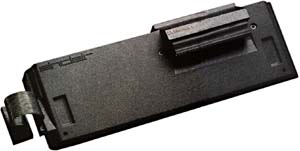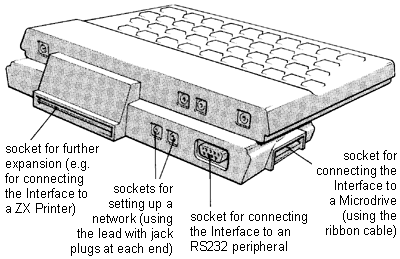|
Interface 1
1983

 |
eBay
online auctions |
| Collectors frequently sell old Sinclair products
on eBay.co.uk.
Click the "GO" button on the left to find any Sinclair
Interface 1 being auctioned. |
|
| Best
search term: |
(zx,sinclair) interface (1,one,i) |
| Availability:
|
Fairly
common |
| Typical
value: |
£30-£40 |
| |
More
info on buying & selling Sinclair computers |
Interface 1 was perhaps the
most interesting of Sinclair Research's small peripherals
range. As well as providing connectivity to the Microdrive
mass storage device, Interface 1 also serves as an RS232 interface
and local area network (LAN) device. The device fits underneath
the Spectrum, tilting the keyboard to a more comfortable typing
angle. Unlike the RAM packs, it has no "wobble"
problem, as it can be secured in place with screws passing
through the device into two existing screw holes on the underside
of the Spectrum.
 Most
users of the interface would have used it to connect to the
Microdrive - it was sold in a special "ZX
Spectrum Expansion System" package along with
the Microdrive for £79.95, or £49.95 on its own.
Connected to the Interface via ribbon cables, up to eight
Microdrives can be connected at once. Most
users of the interface would have used it to connect to the
Microdrive - it was sold in a special "ZX
Spectrum Expansion System" package along with
the Microdrive for £79.95, or £49.95 on its own.
Connected to the Interface via ribbon cables, up to eight
Microdrives can be connected at once.
The RS232 (serial) interface
was a fairly standard design, capable of being used at up
to 19.2Kbps with devices such as printers and modems.
The network interface was perhaps
the most interesting element. A LAN (or "ZX Net")
is set up by simply joining two Spectrum interfaces together
with the 10-foot long net lead. Up to 64 Spectrums connected
at 100 baud can be connected this way. A broadcast feature
enables one Spectrum to transfer data to any other machines
connected to the network, and that one machine can also be
used as a server - for example, to provide printer output
from any other networked machine.
The network facility was in
fact the original raison d'être of the Interface
1 - the Microdrive interface came at a later stage - and was
probably intended to improve the Spectrum's usefulness in
an educational environment. A class issued with networked
Spectrums, for example, could be supervised by a teacher with
a master terminal. If this was the intention, then it seems
to have fallen somewhat flat - Sinclair captured only a paltry
share (less than 2%) of an educational market overwhelmingly
dominated by Acorn's BBC Micro.
The Interface 2 (in its original
form as a network interface) was planned even before the release
of the ZX Spectrum in April 1982. The Spectrum came with a
number of initially mysterious commands on the top row of
the keyboard - OPEN #, CLOSE #, MOVE, ERASE, CAT and FORMAT.
On a Spectrum 16K or 48K without an Interface 1 plugged in,
these commands do nothing much. In fact, they are not even
present in the ROM; the machine has to call a "shadow
ROM" hosted in the Interface 1 to handle these commands.
This was due to slippage in Sinclair's development of the
Spectrum and its peripherals. After the premature departure
of the Spectrum's designer, Richard Altwasser, in February
1982, the development schedule was thrown way off target.
The Spectrum consequently shipped with what amounted to an
unfinished ROM, with 1300 bytes unused - a comparatively huge
amount at a time when every last byte counted. This gap was
where the networking code would have resided, hence the computer's
reliance on an external "shadow ROM" which switched
in and out as needed.

Back
to top
© Chris Owen 1994-2003
|